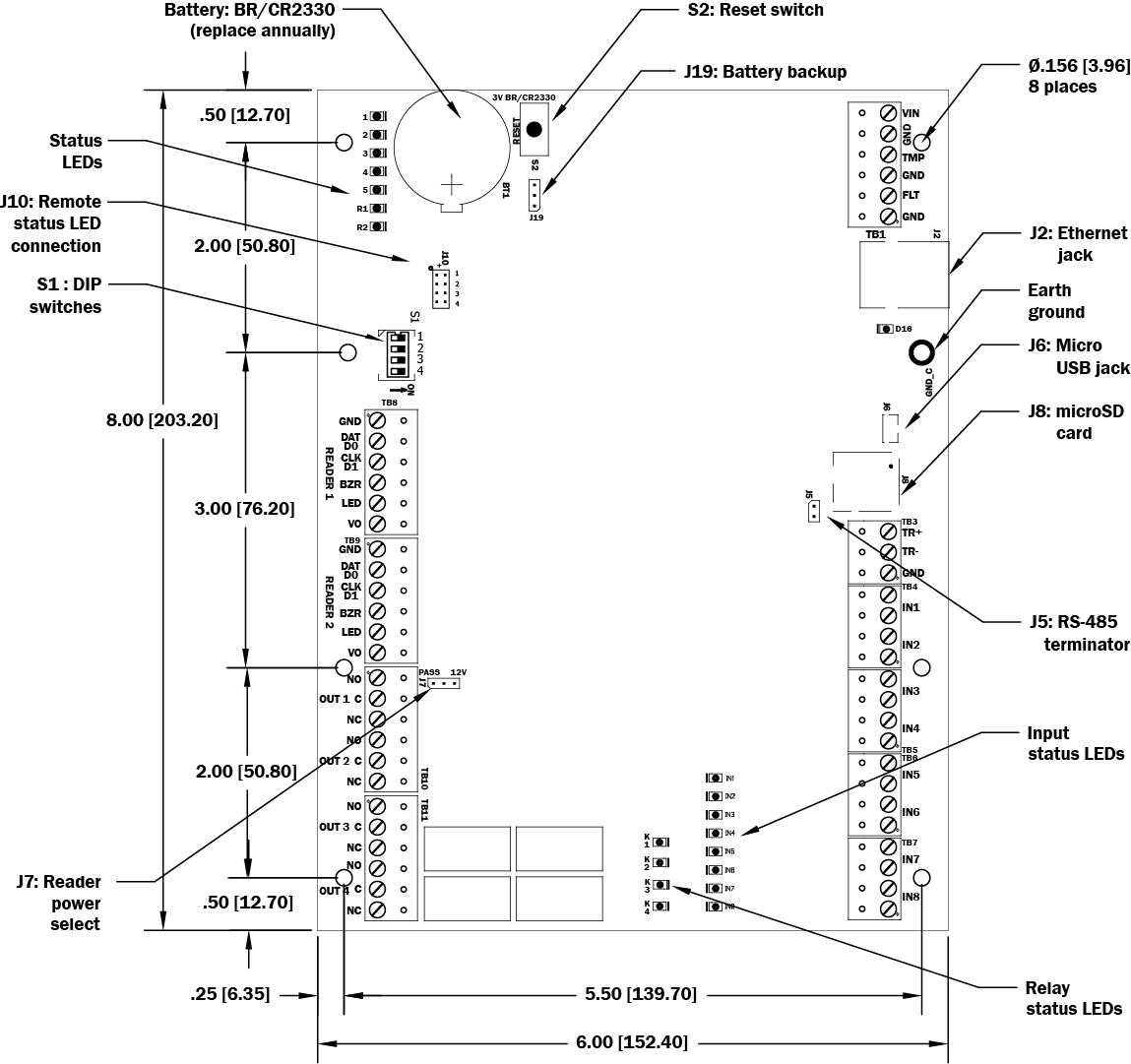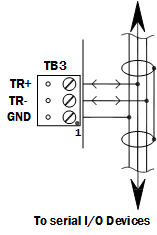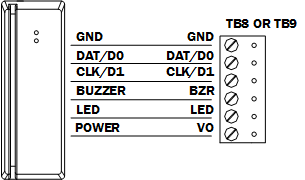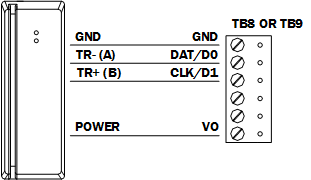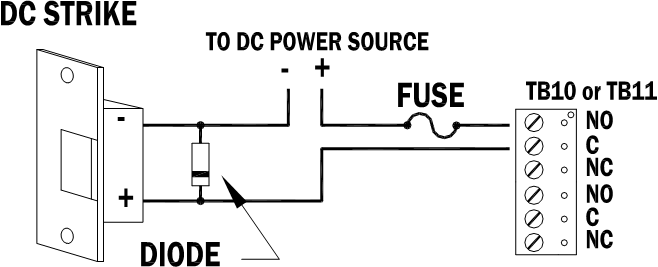General
The LNL-X2220 intelligent controller provides decision making, event reporting, and database storage for the Lenel hardware platform. Two reader interfaces provide control for two physical barriers.
The LNL-X2220 communicates with the host via on-board 10-BaseT/100Base-TX Ethernet port or the Micro USB port (2.0) with an optional Micro USB to Ethernet adapter.
Each reader port can accommodate a reader that utilizes TTL (D1/D0, Clock/Data) or 2-wire RS-485 device signaling (OSDP reader for example) and also provides tri-state LED control, and buzzer control (one wire LED mode only). Four Form-C relay outputs may be used for door strike control or alarm signaling. Eight inputs are provided that may be used for monitoring the door contacts, exit push buttons, and alarm contacts. Input circuits may be configured as unsupervised or supervised. The LNL-X2220 requires 12 to 24 VDC for power.
LNL-X2220 Hardware
LNL-X2220 Wiring and Setup
Terminal Blocks 1-7 Connections | ||
|---|---|---|
TB1-1 | Power Fault Input | GND |
TB1-2 | FLT | |
TB1-3 | Cabinet Tamper Input | GND |
TB1-4 | TMP | |
TB1-5 | Power Input | GND |
TB1-6 | VIN: 12 to 24 VDC | |
TB2 | N/A | Not Used |
TB3-1 | SIO Port (2-wire RS-485) | GND |
TB3-2 | TR- (B) * | |
TB3-3 | TR+ (A) * | |
TB4-1 | Input 2 | IN2 |
TB4-2 | IN2 | |
TB4-3 | Input 1 | IN1 |
TB4-4 | IN1 | |
TB5-1 | Input 4 | IN4 |
TB5-2 | IN4 | |
TB5-3 | Input 3 | IN3 |
TB5-4 | IN3 | |
TB6-1 | Input 6 | IN6 |
TB6-2 | IN6 | |
TB6-3 | Input 5 | IN5 |
TB6-4 | IN5 | |
TB7-1 | Input 8 | IN8 |
TB7-2 | IN8 | |
TB7-3 | Input 7 | IN7 |
TB7-4 | IN7 | |
* Terms A & B are from the RS-485 standard.
Terminal Blocks 8-11 Connections | ||
|---|---|---|
TB8-1 | Reader 1 | GND: Ground |
TB8-2 | DAT/D0: Data/Data 0/ TR- (A) * | |
TB8-3 | CLK/D1: Clock/Data 1/ TR+ (B) * | |
TB8-4 | BZR: Reader Buzzer | |
TB8-5 | LED: Reader LED | |
TB8-6 | VO: Reader Power | |
TB9-1 | Reader 2 | GND: Ground |
TB9-2 | DAT/D0: Data/Data 0/ TR- (A) * | |
TB9-3 | CLK/D1: Clock/Data 1/ TR+ (B) * | |
TB9-4 | BZR: Reader Buzzer | |
TB9-5 | LED: Reader LED | |
TB9-6 | VO: Reader Power | |
TB10-1 | Out 1 | NO: Normally Open Contact |
TB10-2 | C: Common | |
TB10-3 | NC: Normally Closed Contact | |
TB10-4 | Out 2 | NO: Normally Open Contact |
TB10-5 | C: Common | |
TB10-6 | NC: Normally Closed Contact | |
TB11-1 | Out 3 | NO: Normally Open Contact |
TB11-2 | C: Common | |
TB11-3 | NC: Normally Closed Contact | |
TB11-4 | Out 4 | NO: Normally Open Contact |
TB11-5 | C: Common | |
TB11-6 | NC: Normally Closed Contact | |
* Terms A & B are from the RS-485 standard.
Jumpers and Jacks
The LNL-X2220 processor hardware interface is configured using jumpers to setup the reader port power and end of line termination.
Jumpers | Set at | Description |
|---|---|---|
J1 | N/A | Factory Use Only |
J2 | N/A | 10-Base-T/100Base-Tx Ethernet Connection (Port 0) |
J3 | N/A | Factory Use Only |
J4 | N/A | N/A |
J5 | OFF | RS-485 EOL Terminator is Off |
ON | RS-485 EOL Terminator is On | |
J6 | N/A | Micro USB Port (2.0) |
J7 | Reader Power Select * | |
12V | 12 VDC at Reader Ports | |
PASS | VIN "Pass Through" to Reader Ports | |
J8 | N/A | microSD Card |
J10-1 | N/A | Remote Status LED #1 ** |
J10-2 | N/A | Remote Status LED #2 ** |
J10-3 | N/A | Remote Status LED #3 ** |
J10-4 | N/A | Remote Status LED #4 ** |
J19 | OFF | Battery backup is OFF |
ON | Backup battery is ON. Refer to Memory and Real Time Clock Backup Battery. | |
* Install jumper J7 in the 12V position ONLY if the input voltage (VIN) is greater than 20 VDC. Failure to do so may damage the reader or LNL-X2220.
**Observe polarity connection to LED. External current limiting is not required.
DIP Switches
The four switches on S1 DIP switch configure the operating mode of the LNL-X2220 processor. DIP switches are read on power-up except where noted.
Pressing reset switch S2 causes the LNL-X2220 to reboot.
1 | 2 | 3 | 4 | Definition |
|---|---|---|---|---|
OFF | OFF | OFF | OFF | Normal operating mode. |
ON | X | OFF | OFF | After initialization, enable default User Name (admin) and Password (password). The switch is read on the fly, no need to reboot. For more information, refer to IT Security. |
OFF | ON | OFF | OFF | Use factory default communication parameters.* |
ON | ON | OFF | OFF | Use Lenel default communication parameters.* Contact system manufacturer for details. See Bulk Erase Configuration Memory. |
ON | ON | OFF | OFF | Bulk Erase prompt mode at power up. See Bulk Erase Configuration Memory. |
X | X | X | ON | Makes the LNL-X2220 report and function like an LNL-2220. To be used in situations where the host software has not been updated to support the LNL-X series product line. |
X = ON or OFF. All other switch settings are unassigned and reserved for future use.
* In the factory or Lenel default modes, downloaded configuration/database is not saved to flash memory.
Factory Default Communication Parameters
Interface 1 (NIC1)
- Network: static IP address: 192.168.0.251
- Subnet Mask: 255.255.0.0
- Default Gateway: 192.168.0.1
- DNS Server: 192.168.0.1
- Primary Host port: IP server, Data Security: TLS if Available, port 3001, communication address: 0
- Alternate Host Port: Disabled
Bulk Erase Configuration Memory
The bulk erase function can be used for the following purposes:
- Erase all configuration and cardholder database (sanitize board, less third party applications)
- Update OEM default parameters after OEM code has been changed
- Recover from database corruption causing LNL-X2220 board to continuously reboot
If clearing the memory does not correct the initialization problem, contact technical support.
Bulk Erase Steps
Important
Do not remove power during steps 1-6.
- Set S1 DIP switches to: 1 & 2 "ON," 3 & 4 "OFF."
- Apply power to the LNL-X2220 board. LED 1 on for about 15 seconds while LNL-X2220 boots up.
- After the LNL-X2220 boots up, watch for LEDs 1 & 2 and 3 & 4 to alternately flash at a 0.5 second rate.
- Within 10 seconds after the above pattern starts, change switches 1 or 2 to "OFF." If these switches are not changed, the LNL-X2220 board will power up using the OEM default communication parameters.
- LED 2 will flash indicating that the configuration memory is being erased. Full memory erase takes up to 60 seconds, usually a lot less. When complete, only LEDs 1 & 4 will flash for about 3 seconds.
- The LNL-X2220 board will complete its initialization in 2 seconds after LEDs 1 & 4 stop flashing.
Reader Wiring
Each reader port supports a reader with TTL (D1/D0, Clock/Data) or 2-wire RS-485 signaling (OSDP reader for example). Power to the readers is selectable: 12 VDC (VIN must be greater than 20 VDC), or power is passed-through (PASS) from the input voltage of the LNL-X2220 (TB1-VIN), 300 mA maximum per reader port. Readers that require different voltage or have high current requirements must be powered separately. Refer to the reader manufacturer’s specifications for cabling requirements. In the 2-wire LED mode, the buzzer output is used to drive the second LED. Reader port configuration is set via the host software.
To fully utilize each reader port:
- TTL signaling requires a 6-conductor cable (18 AWG)
- RS-485 signaling requires two 2-conductor cables. Use one cable for power (18 AWG) and one cable for communication (24 AWG, with drain wire and shield).
Notes
For OSDP cable lengths greater than 200 ft (61 m) or EMF interference, install 120Ω +/- 2Ω resistor across RS-485 termination ends.
Data 0 and Data 1 wires for Wiegand may be reused for OSDP. However, standard Wiegand cable may not meet RS-485 twisted pair recommendations. The reuse of cable works best on shorter cable lengths at lower data rates.
12V PASS | J7 Reader Power Select |
|---|---|
12 VDC is available on reader ports (VIN is greater than or equal to 20 VDC). | |
VIN power is “passed through” (PASS) to reader ports. |
Caution
Typical D1/D0 or Clock/Data Reader
Typical 2-wire RS-485 Device (such as OSDP Reader)
Input Circuit Wiring
There are 8 inputs that are typically used to monitor door position, request to exit, or alarm contacts. Input circuits can be configured as unsupervised or supervised. When unsupervised, reporting consists of only the open or closed states. When configured as supervised, the input circuit will report not only open and closed, but also open circuit, shorted, grounded, and foreign voltage. A supervised input circuit requires two resistors be added to the circuit to facilitate proper reporting. The standard supervised circuit requires 1k ohm, 1% resistors and should be located as close to the sensor as possible. Custom end of line (EOL) resistances may be configured via the host software.
The input circuit wiring configurations shown are supported but may not be typical:
Relay Circuit Wiring
Four relays with Form-C contacts (dry) are provided for controlling door lock mechanisms or alarm signaling. Each relay has a Common pole (C), a Normally Open pole (NO) and a Normally Closed pole (NC). When controlling the delivery of power to the door strike, the Normally Open and Common poles are typically used. When momentarily removing power to unlock the door, as with a magnetic lock, the Normally Closed and Common poles are typically used. Check with local building codes for proper egress door installation.
Door lock mechanisms can generate feedback to the relay circuit that can cause damage and premature failure of the relay plus affect the operation of the LNL-X2220. For this reason, it is recommended that a diode be used to protect the relay. Wire should be of sufficient gauge to avoid voltage loss.
Diode Selection
Diode current rating: 1x strike current. Diode breakdown voltage: 4x strike voltage. For 12 VDC or 24 VDC strike, diode 1N4002 (100V/1A) typical.
Memory and Real Time Clock Backup Battery
The static RAM and the real time clock are backed up by a lithium battery when input power is removed. This battery should be replaced annually. If data in the static RAM is determined to be corrupt after power up, all data, including flash memory, is considered invalid and is erased. All configuration data must be re-downloaded.
During installation and while the unit is not powered, change the jumper (J19) position from OFF to ON to enable the battery backup.
Battery type: BR2330 or CR2330.
IT Security
When installing the LNL-X2220, it is important to ensure that it is done in a secure manner.
Upon installation, the user accounts to the web configuration page should be created with secure passwords, and that all DIP switches are in the off position for the normal operating mode. The LNL-X2220 is shipped from the factory with a default login account, which is enabled when DIP 1 is moved from OFF to ON. The default login user name and password will be available for five minutes once enabled. Therefore, it is important that at least one user account is defined, and the DIP switches are set to OFF before the LNL-X2220 is commissioned. It is also highly recommended not to configure the LNL-X2220 with an IP address that is accessible from the public Internet.
To further enhance network security, options are available to disable SNMP, Zeroconf discovery, as well as the web configuration module itself. Additionally, data encryption can be enabled over the host communication port.
Status LEDs
Power-up: All LEDs OFF.
Initialization: After power is applied or the reset switch is pressed, LED 1 is ON for about 15 seconds, then LEDs 2 through 6, R1, R2, and IN1 through IN8 are flashed once at the beginning of initialization.
LEDs 3 and 4 turn ON for approximately 1 second after the hardware initialization has completed, then the application code is initialized. The amount of time the application takes to initialize depends on the size of the database, about 1 second without a card database. Each 10,000 cards adds about 2 seconds to the application initialization.
When LEDs 1 through 4 flash at the same time, data is being read from or written to flash memory; do not cycle power when in this state.
If the sequence stops or repeats, perform Bulk Erase Steps.
Running: After initialization is complete, the LEDs have the following meanings:
LED | Description |
|---|---|
1 | Off-line / On-line and battery status |
Off-line = 20% ON, On-line = 80% ON | |
Double flash if battery is low | |
2 | Host communication activity (Ethernet or Micro USB port) |
3 | Internal SIO communication activity |
4 | External SIO communication activity |
5 | Unassigned |
R1 | Reader 1 |
R2 | Reader 2 |
D16 | Flashes with Ethernet traffic |
YEL | Ethernet Speed: OFF = 10 Mb/S, ON = 100 Mb/S |
GRN | OFF = No Link, ON = Good Link, Flashing = Ethernet Activity |
IN1 - IN8 | OFF = Inactive, ON = Active, Flash = Fault * |
K1 - K4 | ON = Energized |
* If this input is defined, every three seconds the LED is pulsed to its opposite state for 0.1 seconds, otherwise, the LED is off.
Specifications
The interface is for use in low voltage, Class 2 circuits only.
The installation of this device must comply with all local fire and electrical codes.
- Primary Power: 12 to 24 VDC ± 10%, 500 mA maximum (reader and USB ports not included)
- Reader Ports: 600 mA maximum (add 600 mA to primary power current)
- Micro USB Port: 5 VDC, 500 mA maximum (add 270 mA to primary power current)
- Memory and Clock Backup Battery: 3 Volt Lithium, type BR2330 or CR2330
- microSD Card: Format: microSD or microSDHC; 2GB to 8GB
- Host Communication: Ethernet: 10-BaseT/100Base-TX and Micro USB port (2.0) with optional adapter: pluggable model USB2-OTGE100
- Serial I/O Device: Two each: 2-wire RS-485, 2,400 to 115,200 bps, asynchronous, half-duplex, 1 start bit, 8 data bits, and 1 stop bit
- Inputs: Eight unsupervised/supervised, standard EOL: 1k/1k ohm, 1%, ¼ watt
Two unsupervised dedicated for cabinet tamper and UPS fault monitoring - Outputs: Four relays, Form-C with dry contacts
Normally open contact (NO) contact: 5 A @ 30 VDC resistive
Normally closed contact (NC) contact: 3 A @ 30 VDC resistive - Reader Interface:
- Power (jumper selectable): 12 VDC ± 10% regulated, 300 mA maximum each reader (input voltage (VIN) must be greater than 20 VDC) or
12 to 24 VDC ± 10% (input voltage (VIN) passed through), 300 mA maximum each reader - Data Inputs: TTL compatible or 2-wire RS-485
- RS-485 Mode: 9,600 to 115,200 bps, asynchronous, half-duplex, 1 start bit, 8 data bits, and 1 stop bit. Maximum cable length: 2000 ft. (609.6 m)
- LED Output: TTL levels, high>3 V, low<0.5 V, 5 mA source/sink maximum
- Buzzer Output: Open collector, 12 VDC open circuit maximum, 40 mA sink maximum
- Power (jumper selectable): 12 VDC ± 10% regulated, 300 mA maximum each reader (input voltage (VIN) must be greater than 20 VDC) or
- Cable Requirements:
- Power: 1 twisted pair, 18 to 16 AWG
- Ethernet: CAT-5, minimum
- RS-485:
- I/O Device Port: 1 twisted pair, shielded, 120 ohm impedance, 24 AWG, 4,000 ft. (1,219 m) max.
- Reader Port: 1 twisted pair, shielded, 120 ohm impedance, 24 AWG, 2,000 ft. (610 m) max.
- Alarm Input: 1 twisted pair, 30 ohm maximum
- Environmental:
- Temperature:
Storage: -55 to +85 °C (-67° to 185° F)
Operating: 0 to +70 °C (32° to 158° F) - Humidity: 5 to 95% RHNC
- Temperature:
- Mechanical:
- Dimensions: 8 in. (203.2 mm) W x 6 in. (152.4 mm) L x 1 in. (25 mm) H
- Weight: 9 oz. (255 g) nominal, board only
These specifications are subject to change without notice.
Regulatory Information
FCC Compliance
This device complies with part 15 of the FCC Rules. Operation is subject to the following two conditions: (1) This device may not cause harmful interference, and (2) this device must accept any interference received, including interference that may cause undesired operation.
Liability
It is expressly understood and agreed that the interface should only be used to control exits from areas where an alternative method for exit is available. This product is not intended for, nor is rated for operation in life-critical control applications. LenelS2 is not liable under any circumstances for loss or damage caused by or partially caused by the misapplication or malfunction of the product. LenelS2’s liability does not extend beyond the purchase price of the product.
Certifications
For certification information, refer to the hardware documentation for the host application.
Product Warnings and Disclaimers
THESE PRODUCTS ARE INTENDED FOR SALE TO, AND INSTALLATION BY, AN EXPERIENCED SECURITY PROFESSIONAL. LENELS2 CANNOT PROVIDE ANY ASSURANCE THAT ANY PERSON OR ENTITY BUYING ITS PRODUCTS, INCLUDING ANY “AUTHORIZED DEALER”, IS PROPERLY TRAINED OR EXPERIENCED TO CORRECTLY INSTALL SECURITY RELATED PRODUCTS. FOR MORE INFORMATION ON PRODUCT WARNINGS AND DISCLAIMERS, SEE THE "LENELS2 PRODUCT WARNINGS AND DISCLAIMERS" KNOWLEDGE BASE ARTICLE IN THE LENELS2 KNOWLEDGE BASE. THIS INFORMATION IS SUBJECT TO CHANGE WITHOUT NOTICE.
© 2025 Honeywell International Inc. All Rights Reserved.
